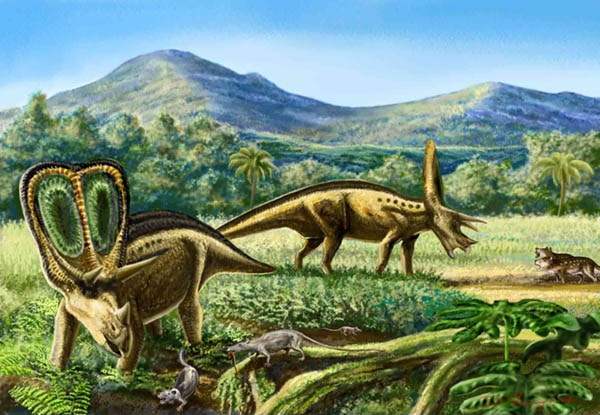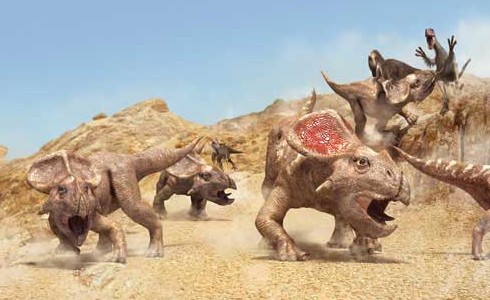澳洲恐龙洞穴揭示气候变化
By 苏剑林 | 2009-07-14 | 33004位读者 |笔录:
长文章更能够显示出一个人的翻译能力和翻译耐心——除了要有熟悉的语言处理能力外,还有持之以恒。现在大家来评价下翻译得如何吧!
这一次讲述的是关于恐龙的问题,再次联系到了气候变暖的问题。既然在千万年前气候变暖已经这么严重了,那么恐龙们能够熬过这一关吗?能!因为它们挖洞了。让我们来走近它们!
标题:澳洲恐龙洞穴揭示气候变化
“这项研究能够帮助我们更好地了解长期地质变化,以及生物体是如何调整应对地球的气候变冷和变暖周期的,”艾莫里(Emory)的高级环境讲师 马丁(Martin) 说。马丁也是墨尔本莫纳什大学地荣誉研究员。
2006年,马丁与来自日本和蒙大拿州立大学的同伴们合作,在蒙大拿州西南部的洞穴中发现了9500万年前的一头小型成年恐龙和两头幼龙。后来,他们将这种恐龙命名为“Oryctodromeus cubicularis”,意思是“洞穴挖掘专家”。
研究人员推测,穴居除了为更好地照顾幼龙外,也可能是在一些恐龙灭绝理论所认为的、极端的环境下的一种生存方式。
在蒙大拿州发现恐龙的一年后,马丁前往了过去曾与南极洲接壤的维多利亚海岸。在维多利亚的早期白垩纪岩层中,已经取得了世界上最好的极地恐龙化石研究成果。
维多利亚的墨尔本西部有一个以印第安人闻名的偏远地区,在一次徒步旅行中,马丁环绕着裸露的地表,突然他惊奇地看到,在眼睛右边的洞穴遗址,几乎和他在蒙大拿州发现的一模一样。“我盯了它(化石)很长时间,”马丁回忆说,“在古生物学中的一句谚语'where luck meets preparation'真的很对。”
(注:where luck meets preparation,^_^,惭愧,这一句看不懂。)
根据风化的结果推测原洞穴有6英尺长,直径为1英尺,螺旋式平缓下落,内部较大。后来马丁在同一地区发现了两个类似的遗址。
全球气候变暖时期
维多利亚发现的遗址大约出现在1.1亿年前,这与南极洲和澳大利亚分离、恐龙出没在靠近南极的澳大利亚长满树木的平原地区 的时间吻合。这是一个经历着全球变暖的时期,温度大约为68华氏度(20摄氏度)——比现在大约高出10度(指的是极地地区的温度)。
而在极地冬季,气温会下降到冰点以下。此前,研究人员推测幼龙是躲在大树根或洼地下,才能够在恶劣的环境中生存下来。但马丁的发现表明,它们可能会挖掘松软的河丘,进入到裂谷中生活。
马丁推测,从洞穴的年龄、规模和形状来看,它们是一些小型鸟脚亚目恐龙——那个地区普遍生活着的食草动物——所挖掘的。这些鸟脚亚目恐龙能够两脚直立,大小相当于现代的大型鬣蜥。
“这是一个迷人的发现,它找到了生活在不同半球、不同时期、看似不相关的恐龙之间有着一种行为的关联的证据,”马丁表示,“它填补了我们了解恐龙的演化和极端环境生存的一个空白。”
发现细微的线索
遗迹化石——包括踪迹、粪便和洞穴——的专家马丁,以检测古生物的细微证据闻名。他还是首次发现维多利亚上的大型食肉恐龙存在的踪迹,以及在该地区发现第一批淡水螯虾洞穴化石的人。
在艾莫里,马丁教授研究小组动物跟踪技术——帮助他发现史前生活的迹象的技能。“更重要的是到野外做更多的实地考察工作,这会比你在图书馆发现得更多。”他说。
原文来自ScienceDaily网站,以下是原文内容:
Down Under Dinosaur Burrow Discovery Provides Climate Change Clues
"This research helps us to better understand long-term geologic change, and how organisms may have adapted as the Earth has undergone periods of global cooling and warming," says Martin, a senior lecturer in environmental studies at Emory. Martin is also an honorary research associate at Monash University in Melbourne.
In 2006, in collaboration with colleagues from Montana State University and Japan, Martin identified the 95-million-year-old skeletal remains of a small adult dinosaur and two
juveniles in a fossilized burrow in southwestern Montana. They later named the dinosaur species oryctodromeus cubicularis, meaning "digging runner of the lair."
The researchers hypothesized that, besides caring for young in their dens, burrowing may have allowed some dinosaurs to survive extreme environments – throwing a wrench in some extinction theories.
A year after the Montana find, Martin traveled to the Victoria coast, which marks the seam where Australia once snuggled against Antarctica. Lower Cretaceous strata of Victoria have yielded the best-documented assemblage of polar dinosaur bones in the world.
During a hike to a remote site known as Knowledge Creek, west of Melbourne, Martin rounded the corner of an outcropping and was astounded to see, right at eye level, the trace fossil of what appeared to be a burrow almost identical to the one he had identified in Montana. "I stared at it for a long time," recalls Martin. "In paleontology, the saying, 'where luck meets preparation' really holds true."
The probable burrow etched into the Early Cretaceous outcrop is about six-feet long and one-foot in diameter. It gently descends in a semi-spiral, ending in an enlarged chamber. Martin later found two similar trace fossils in the same area.
Last period of global warming
The Victoria fossils are about 110 million years old, around the time that Australia split with Antarctica, and dinosaurs roamed in prolonged polar darkness along forested southern Australia river plains. It was one of the last times the Earth experienced global warming, with an average temperature of 68 degrees Fahrenheit – about 10 degrees higher than today.
During the polar winter, though, the temperature could plunge below freezing. Previously, researchers theorized that the small dinosaurs in the region survived harsh weather by sheltering beneath large tree roots or in hollows. Martin's find, however, indicates that they may have dug into the soft banks of rivers flowing out of the rift valley.
The age, size and shape of the likely burrows led Martin to hypothesize that they were made by small ornithopod dinosaurs – herbivores that were prevalent in the region. These ornithopods stood upright on their hind legs and were about the size of a large, modern-day iguana.
"It's fascinating to find evidence connecting a type of behavior between dinosaurs that are probably unrelated, and lived in different hemispheres during different times," Martin says. "It fills in another gap in our understanding of the evolution of dinosaurs, and ways they may have survived extreme environments."
An eye for subtle clues
A specialist in trace fossils – including tracks, scat and burrows – Martin is known for detecting subtle paleontology clues. He also identified the first tracks of a large, carnivorous dinosaur in Victoria, and the first fossil crayfish burrows from the same area.
Martin teaches a seminar at Emory on modern-day animal tracking, a skill that he says aids him in finding signs of prehistoric life. "It's important to do as much field work as possible, because it gives your mind a better library of search images," he says.
转载到请包括本文地址:https://spaces.ac.cn/archives/19
更详细的转载事宜请参考:《科学空间FAQ》
如果您还有什么疑惑或建议,欢迎在下方评论区继续讨论。
如果您觉得本文还不错,欢迎分享/打赏本文。打赏并非要从中获得收益,而是希望知道科学空间获得了多少读者的真心关注。当然,如果你无视它,也不会影响你的阅读。再次表示欢迎和感谢!
如果您需要引用本文,请参考:
苏剑林. (Jul. 14, 2009). 《澳洲恐龙洞穴揭示气候变化 》[Blog post]. Retrieved from https://spaces.ac.cn/archives/19
@online{kexuefm-19,
title={澳洲恐龙洞穴揭示气候变化},
author={苏剑林},
year={2009},
month={Jul},
url={\url{https://spaces.ac.cn/archives/19}},
}













July 14th, 2009
“中国科学网”的站长将
where luck meets preparation,译为:机遇总是留给有准备的人
大家参考下吧。